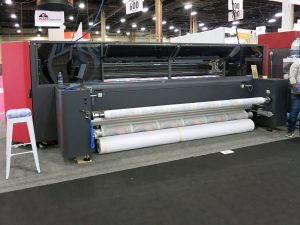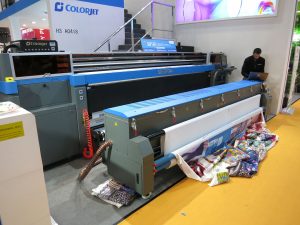Digital Textile Printing, is it Sustainable?
María Renée Ayau and Dr Nicholas Hellmuth

The world is changing and more and more and people are looking for sustainable alternatives, it is not enough to have a product that is good enough or that complies only with a few regulations.
Consumers are becoming more eco-conscious than before and more informed, but some are even willing to pay more for a product that is more eco-friendly than one that is not.
According to Nielsen, Global consumer and media insights: “Millennials report a greater willingness to pay more for products with ingredients that are sustainable, environmentally friendly, organic or natural, or socially responsible products. Also, Millennials report a greater willingness to pay more for products with ingredients that are sustainable, environmentally friendly, organic or natural, or socially responsible products”.
Manufacturers are now more focused on producing more sustainable options not only to meet the consumer demand; but also because eco-consciousness is growing and are pulling efforts to create a smaller ecological footprint. The main goal is to reduce the impact of the printing process and guarantee that it is carried in a responsible and sustainable way.
One of the most water polluting industries in the world is the textile manufacturing industry. This industry produces an estimated 20% of water pollution, mostly resulting from textile dyeing and treatment. Most of the pollution from textile manufacturing is from the wastewater that contains chemicals such as lead, phthalates, and other chemicals that later reach water bodies and are eventually consumed by living beings.
Many digital printing technologies are more sustainable than their analog counterparts, and textile printing is no exception. So “coloring” fabrics with inkjet ink is dramatically less polluting than mass coloration in factories.
A second of the ways in which digital textile is more sustainable is being better than screen-printing. For example,digital inkjet uses about 10-liters of water per meter, as opposed to the 50-60 liters of water that screen-printing requires. But if you use pigment ink the water consumption is reduced even more, to less than 10-liters per meter, since it does not require water for fixing colors only for finishing.
Another way in which digital is more eco-friendly is because the volume of ink used for printing is 10% less than the amount used in screen-printing. The amount of ink used represents virtually no waste, since the ink drops are printed on demand onto the fabric or transfer paper.
In comparison to screen-printing, digital textile printing is more energy-efficient, since it has a remarkable low consumption of electricity. It is as significant as the water consumption savings, but with 60% less energy consumption is worth considering. Printers are designed with low energy consumption in mind, to help users lower running costs.
Some screens used in screen-printing are coated with lacquer that contains chrome; this may cause contamination by transfer onto the garment. Nowadays this is changing and more and more manufacturers are using nickel-made screens because of its hardness and have changed its shape to use less force to push the printing paste through onto the garment, thus less nickel is deposited into garments. So in this aspect, digital printing is still more sustainable since it does not use this step in is process.


Toxic screen printing?
Screen printing used to be so polluting and toxic. I can remember the screen printing trade shows two decades ago: it was not just the fumes of the solvent inks, it was also the chemicals from the screen printing inks. A second memory-from-the-past is when the university in Ohio moved our office into a building that had been a screen printing company in the previous decade. Even though it had been cleaned up, the chemical waste was still in every drain, in every pore of the floor and wall material. So we had to seal off those rooms and decline to use them (we used only the office rooms that did not have screen printing inks used in them in the past). Today screen printing inks and workflow is definitely improved and I love to see screen printing of T-shirts (especially when it has an digital inkjet station at the end). But the point is, that inkjet, even if “not perfect” is definitely more user friendly than traditions of past decade
Less waste
In terms of material wastage, digital printing is also more efficient, since you print what you need. You also save on storage space and there is no stock waiting to sell; you produce what you needed to sell. It is also important to emphasize that we are moving towards a “circular design” where designers and consumers alike, have to consider both the origin of the product but also the future life of it. The consumer should look for a way to recycle or re purpose the discarded textile, but this is only possible is it is designed using sustainable fabrics.
Recyclable textiles are in a very gray area, when considering if a fabric is sustainable or not there are many factors to consider:
- Is it recyclable?
- Is it recyclable? But animals where harmed when producing it?
- Is it recyclable? But wearing it causes your skin breathing through plastic?
In any case, it is really hard to choose a fabric that is fully sustainable. For example, natural-derived fabrics are considered apt to be recycled. Here are the gray aspects of each:
- Linen: out of all these is the most sustainable, it comes from flax plant and is grown using little water, pesticides or fertilizers.
- Organic cotton: uses lots of water and fertilizers; runoff pollutes streams.
- Silk: the downside is that it is extracted from boiled silkworm cocoons.
- Wool: chemicals are used in the process; it must be bleached before printing. Some farms perform un-ethical practices towards sheep.
On the other hand, some synthetic fabrics are made to be recycled, but have plastic components that can be harmful to the skin, these are not recommended to be worn instead use these for signage purposes. Here are two:
- Tencell or Lyocell: is biodegradable.
- Recycled materials: these are made from regenerated scraps of textile, but have residue of plastic, not ideal to be worn
While there are many positive aspects of traditional printing, digital printing is growing and more into the sustainable side of things. It keeps developing and laws, especially in the EU, are stricter on its guidelines to comply with sustainable practices. So the new technologies are being developed in that line.
There are fabrics all around us that have colorants: most of the clothes that we wear; the curtains in our home and office; rugs and carpets. Almost everything covering out beds. And I can remember my grandmother’s house was about 100% covered with wallpaper. Now even wallpaper is often “wall fabric” and is increasingly printed with inkjet printers.
So it is helpful that many people in many countries are recognizing the need to be ecofriendly. Let’s work together to continue the ecofriendly aspect of textile printing. And, simultaneously, be aware of Greenwashing. Greenwashing is pretending to have a product that is ecofriendly, but an ink or colorant or material that has, deep down within, very unfriendly materials. I look forward to seeing nice textile printers, nice textile inks, and impressive textile applications at SGI 2021 in Dubai in January.






158 Comments